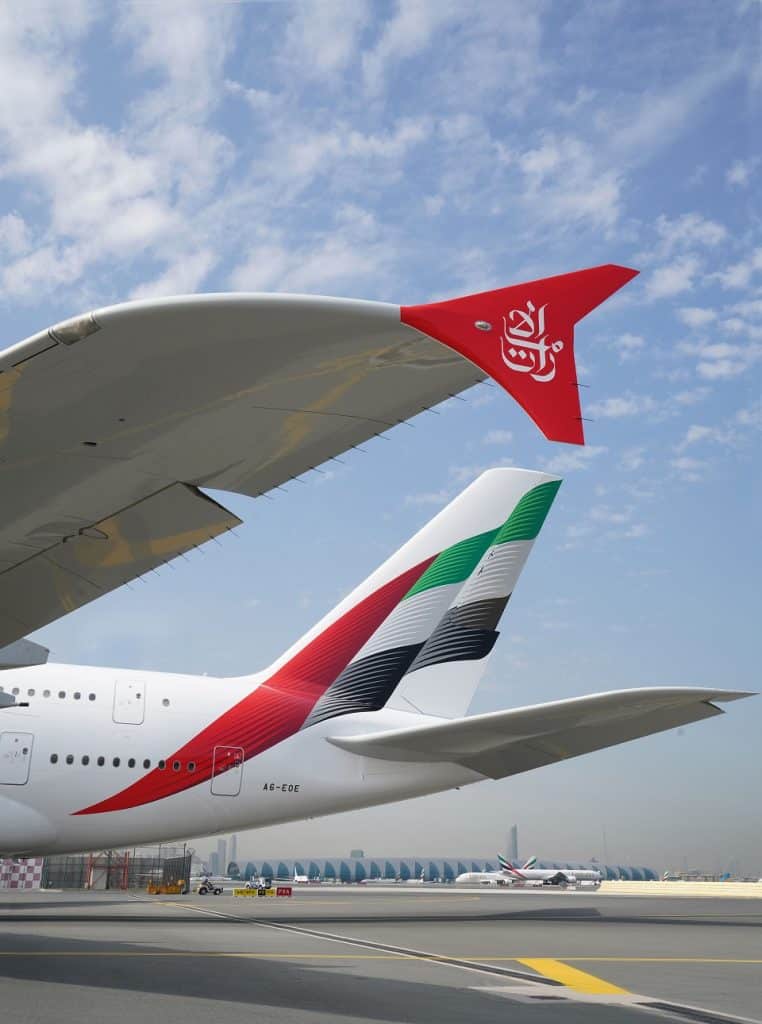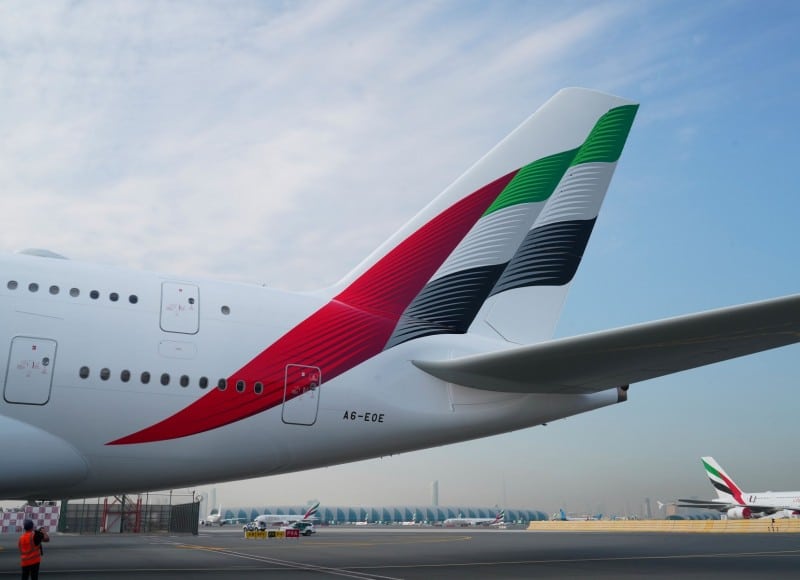Airlines
Emirates unveils new signature livery for its fleet
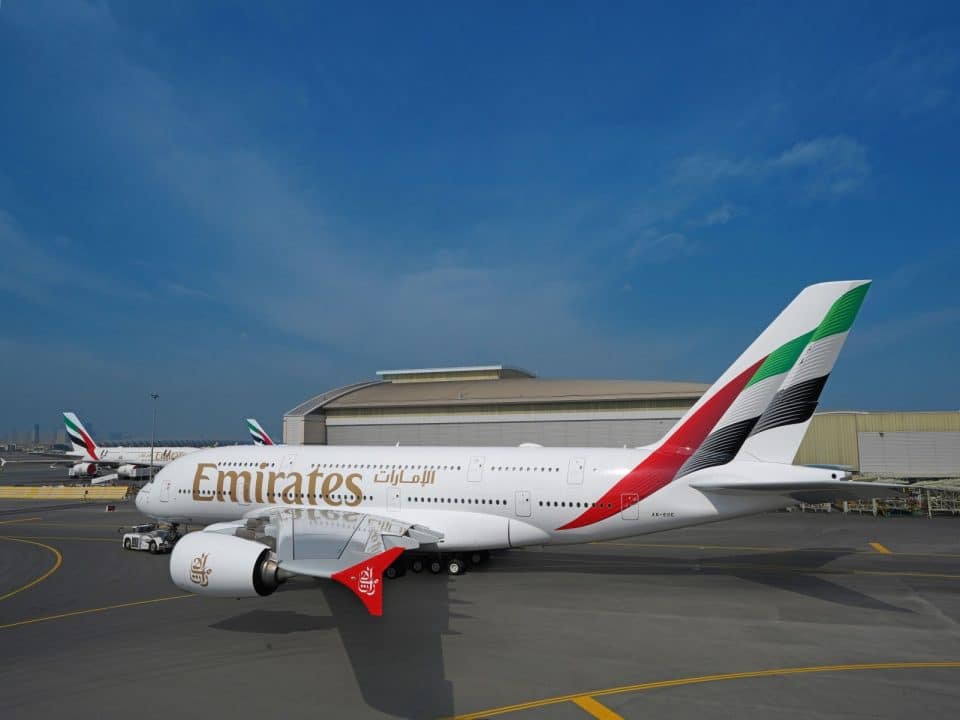
The distinctive livery of the world’s largest international airline, Emirates, has undergone a refresh. Eagle-eyed plane spotters and fans will immediately notice changes to the tailfin and wingtips. In this latest design, the UAE flag on the Emirates tailfin is much more dynamic and flowing with a 3D effect artwork, and the wingtips have been painted red with the Emirates logo in Arabic calligraphy “popping” out in reverse white. Passengers onboard with a window view will see the UAE flag colours painted on the wingtips facing the fuselage.
The signature gold “Emirates” lettering across the main body in English and Arabic is also bolder, and 32.5% larger. On the aircraft belly, Emirates has retained its iconic red branding which it introduced in 2005. The website URL “Emirates.com” has been dropped from the design.
This is the 3rd iteration of Emirates’ official aircraft brand colours. The original livery unveiled with the airline’s launch in 1985 had its first refresh 14 years later, with the delivery of Emirates’ first Boeing 777-300 at the 1999 Dubai Airshow.
The first aircraft to sport Emirates’ newest livery is A6-EOE, an Airbus A380, which has rolled out of Emirates Engineering this week after its makeover. Its first deployment will be to Munich on 17 March as flight EK51.
The new livery will be gradually applied across the rest of the existing Emirates fleet with 24 aircraft, including 17 Boeing 777s, expected to sport the refreshed livery by the end of 2023. All new Emirates aircraft, from the first Airbus A350 entering the fleet in August 2024 will be delivered in this new livery.
Emirates’ original livery in 1985 was designed by the UK design company Negus & Negus. All of the airline’s subsequent aircraft colours were created by its in-house design team. Over the years, Emirates’ numerous colourful and eye-catching aircraft livery have included bespoke designs to drive sponsorship brand association, and for special occasions such as the UAE’s 50th Jubilee livery, and Expo 2020 Dubai.

Airlines
Japan Airlines flight was canceled, after pilot got drunk & rowdy behavior
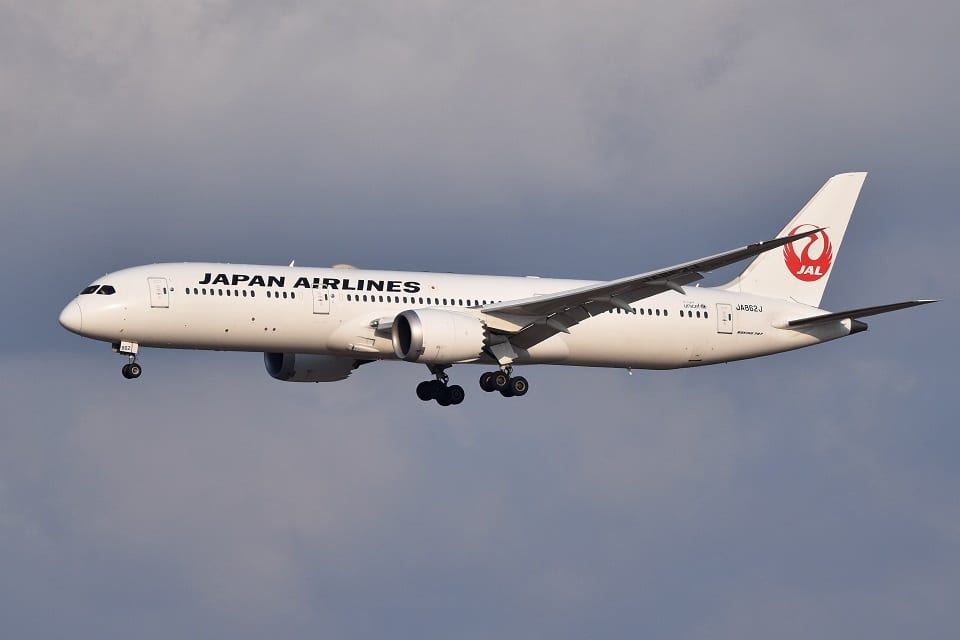
Last week, a routine flight from Dallas Fort Worth to Tokyo Haneda turned into a saga of unexpected turbulence when Japan Airlines Flight JL11 was abruptly grounded due to the unruly conduct of its captain.
The incident, which made headlines in local media, sheds light on the critical issue of alcohol consumption and professional responsibility within the aviation industry. Scheduled to take off at 11:05 am on April 24th, Flight JL11 was poised to ferry 157 passengers across the Pacific on a 12-hour journey to Tokyo.
However, the departure was thwarted as the pilot’s behavior at the crew layover hotel raised serious concerns. Around 2 am, hotel staff were compelled to summon the authorities as the captain’s disruptive antics reverberated through the premises, disturbing fellow guests.
Despite not breaching Japan Airlines’ guidelines regarding alcohol consumption within 12 hours of duty, the pilot’s conduct prompted precautionary measures. While the passengers of Flight JL11 were later accommodated on an American Airlines flight, the repercussions of the pilot’s actions continued to reverberate.
Of particular interest is the fact that the captain wasn’t slated to operate the return flight to Tokyo for over 24 hours, minimizing concerns regarding his sobriety during duty hours. Nevertheless, the incident underscores the complexities surrounding alcohol policies within the airline industry.
Japan Airlines, known for its stringent regulations, imposes a 12-hour prohibition on pilots flying after consuming alcohol, a policy designed to uphold safety standards. Notably, there was a brief period where this cut-off time was extended to 24 hours, highlighting the evolving nature of such protocols.
Following the incident, the pilot was questioned by authorities and cautioned against further misconduct. However, despite assurances, Japan Airlines opted to ground him for the subsequent flight, resulting in the cancellation of the 1:05 am departure when a replacement pilot couldn’t be secured.
In a statement, the airline expressed regret for the inconvenience caused to passengers, attributing the disruption to the pilot’s “inappropriate behavior.”
Airlines
Turkish Airlines in Talks for New Planes, with New MRO Facility
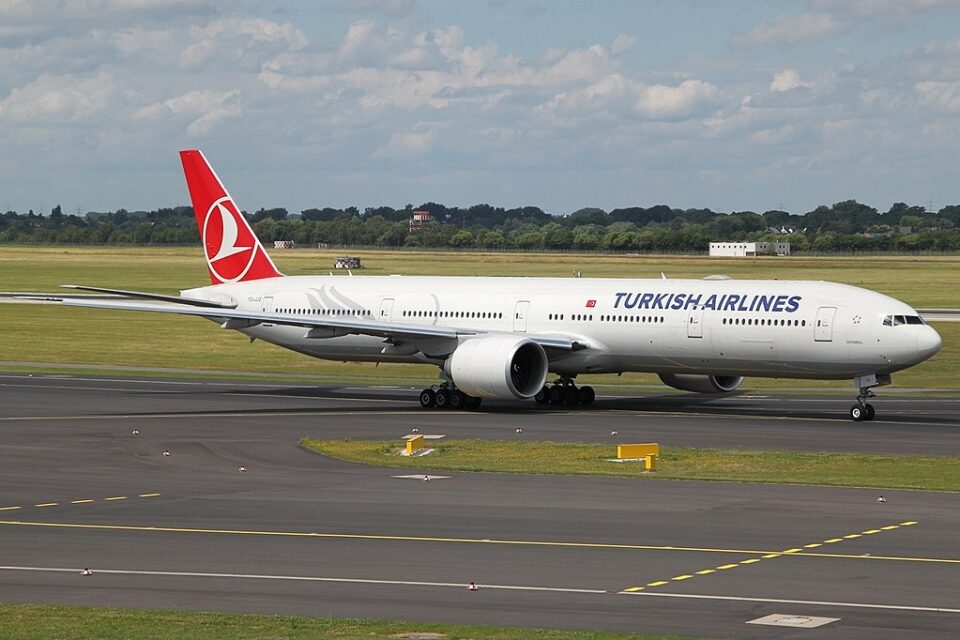
Turkish Airlines is set to embark on a significant expansion journey, eyeing the acquisition of 235 new aircraft from both Airbus and Boeing.
Chairman Ahmet Bolat recently disclosed this development, emphasizing the airline’s commitment to balanced engagement with both major aircraft manufacturers. This move comes in the wake of Turkish Airlines‘ ambitious 10-year fleet plan, unveiled last year, which aims for a substantial increase in its fleet size by nearly 600 planes. As reported by Reuters.
In December, the airline solidified a substantial portion of this plan by securing a deal with Airbus for 355 firm and optional orders, encompassing A321 narrow body and A350 wide body aircraft.
During an event in Istanbul attended by representatives from Airbus and Rolls-Royce, Bolat underscored the airline’s strategy of maintaining equilibrium between Airbus and Boeing. He also highlighted Turkish Airlines’ patience in awaiting resolution of Boeing’s challenges before finalizing its decision.
Moreover, Bolat revealed discussions with Rolls-Royce regarding the potential establishment of maintenance, repair, and overhaul (MRO) capabilities within Türkiye, along with exploring additional avenues for supply-chain sourcing.
Recently, Turkish Airlines is set to redefine luxury air travel with the introduction of its next-generation business class suite, codenamed “Crystal,” slated for release in 2025. These luxurious private suites will first be introduced on the Boeing 777 fleet, with plans to expand to Airbus A350-1000 jets in the future.
The Crystal Suites will feature private compartments with sliding doors, offering passengers an intimate and secluded space to relax and work during their journey. Boasting a 1-2-1 configuration, each seat will provide direct aisle access, ensuring maximum convenience for travelers.
Airlines
Singapore Airlines Ordered to Pay $3,580 to Couple over Faulty Seats
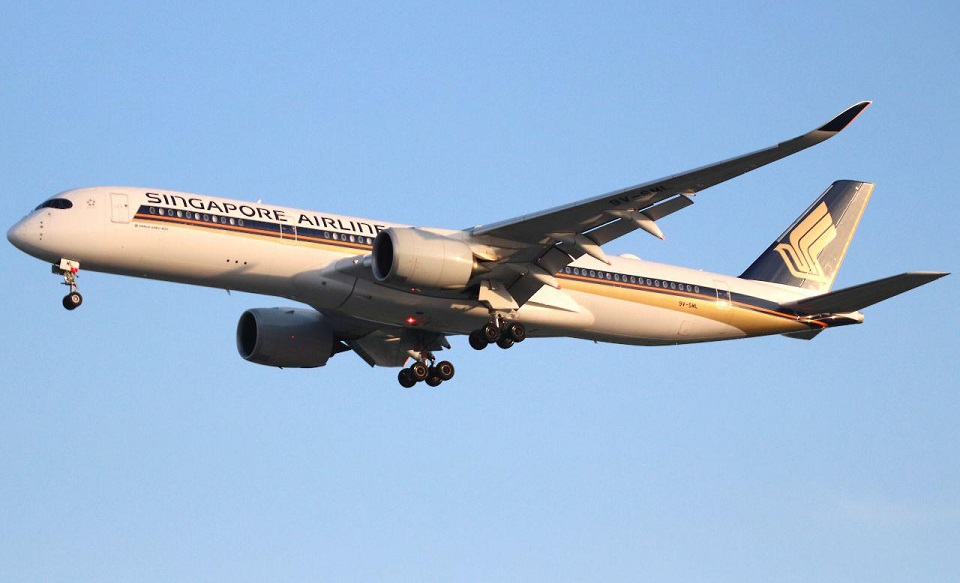
Following a dispute over defective seats during their voyage from India to Australia last year, Singapore Airlines (SIA) has been compelled to pay a sum exceeding S$3,500 to an Indian couple.
The District Consumer Disputes Redressal Commission in Hyderabad ruled in favour of Ravi and Anjali Gupta, who on May 23, 2023, had problems with their business class seats that were meant to automatically recline on their flight from Hyderabad to Australia via Singapore.
Reports from media outlets in India highlighted the discomfort experienced by the couple, who were compelled to endure the entire journey without the benefit of reclining seats, despite having paid a significant amount which cost around 66,750 rupees (S$1,090) for each ticket, lodged a complaint during the flight, expressing their dissatisfaction with the situation.
Singapore Airlines initially offered compensation in the form of 10,000 KrisFlyer miles per person, which was declined by the passengers. As reported by CNA, Singapore Airlines apologised for any difficulty the technical failure may have caused and acknowledged the District Consumer Disputes Redressal Commission of Hyderabad’s ruling.
SIA clarified that while the automatic recline feature on Mr. and Mrs. Gupta’s seats experienced a glitch, the manual recline function remained operational during the flight from Hyderabad to Singapore.
Regrettably, due to a fully occupied flight, SIA staff were unable to arrange alternative seating within the business class cabin. However, the airline asserts that its crew diligently monitored the couple’s comfort throughout the journey, offering to manually adjust the seats as needed.

